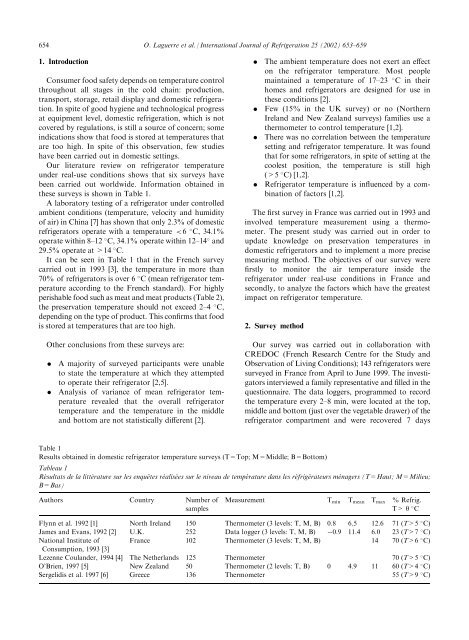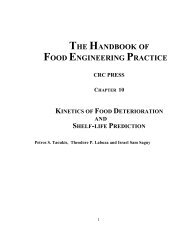Study of domestic refrigerator temperature and analysis of ... - SMAS
Study of domestic refrigerator temperature and analysis of ... - SMAS
Study of domestic refrigerator temperature and analysis of ... - SMAS
You also want an ePaper? Increase the reach of your titles
YUMPU automatically turns print PDFs into web optimized ePapers that Google loves.
654 O. Laguerre et al. / International Journal <strong>of</strong> Refrigeration 25 (2002) 653–659<br />
1. Introduction<br />
Consumer food safety depends on <strong>temperature</strong> control<br />
throughout all stages in the cold chain: production,<br />
transport, storage, retail display <strong>and</strong> <strong>domestic</strong> refrigeration.<br />
In spite <strong>of</strong> good hygiene <strong>and</strong> technological progress<br />
at equipment level, <strong>domestic</strong> refrigeration, which is not<br />
covered by regulations, is still a source <strong>of</strong> concern; some<br />
indications show that food is stored at <strong>temperature</strong>s that<br />
are too high. In spite <strong>of</strong> this observation, few studies<br />
have been carried out in <strong>domestic</strong> settings.<br />
Our literature review on <strong>refrigerator</strong> <strong>temperature</strong><br />
under real-use conditions shows that six surveys have<br />
been carried out worldwide. Information obtained in<br />
these surveys is shown in Table 1.<br />
A laboratory testing <strong>of</strong> a <strong>refrigerator</strong> under controlled<br />
ambient conditions (<strong>temperature</strong>, velocity <strong>and</strong> humidity<br />
<strong>of</strong> air) in China [7] has shown that only 2.3% <strong>of</strong> <strong>domestic</strong><br />
<strong>refrigerator</strong>s operate with a <strong>temperature</strong> 14 C.<br />
It can be seen in Table 1 that in the French survey<br />
carried out in 1993 [3], the <strong>temperature</strong> in more than<br />
70% <strong>of</strong> <strong>refrigerator</strong>s is over 6 C (mean <strong>refrigerator</strong> <strong>temperature</strong><br />
according to the French st<strong>and</strong>ard). For highly<br />
perishable food such as meat <strong>and</strong> meat products (Table 2),<br />
the preservation <strong>temperature</strong> should not exceed 2–4 C,<br />
depending on the type <strong>of</strong> product. This confirms that food<br />
is stored at <strong>temperature</strong>s that are too high.<br />
Other conclusions from these surveys are:<br />
. A majority <strong>of</strong> surveyed participants were unable<br />
to state the <strong>temperature</strong> at which they attempted<br />
to operate their <strong>refrigerator</strong> [2,5].<br />
. Analysis <strong>of</strong> variance <strong>of</strong> mean <strong>refrigerator</strong> <strong>temperature</strong><br />
revealed that the overall <strong>refrigerator</strong><br />
<strong>temperature</strong> <strong>and</strong> the <strong>temperature</strong> in the middle<br />
<strong>and</strong> bottom are not statistically different [2].<br />
. The ambient <strong>temperature</strong> does not exert an effect<br />
on the <strong>refrigerator</strong> <strong>temperature</strong>. Most people<br />
maintained a <strong>temperature</strong> <strong>of</strong> 17–23 C in their<br />
homes <strong>and</strong> <strong>refrigerator</strong>s are designed for use in<br />
these conditions [2].<br />
. Few (15% in the UK survey) or no (Northern<br />
Irel<strong>and</strong> <strong>and</strong> New Zeal<strong>and</strong> surveys) families use a<br />
thermometer to control <strong>temperature</strong> [1,2].<br />
. There was no correlation between the <strong>temperature</strong><br />
setting <strong>and</strong> <strong>refrigerator</strong> <strong>temperature</strong>. It was found<br />
that for some <strong>refrigerator</strong>s, in spite <strong>of</strong> setting at the<br />
coolest position, the <strong>temperature</strong> is still high<br />
(>5 C) [1,2].<br />
. Refrigerator <strong>temperature</strong> is influenced by a combination<br />
<strong>of</strong> factors [1,2].<br />
The first survey in France was carried out in 1993 <strong>and</strong><br />
involved <strong>temperature</strong> measurement using a thermometer.<br />
The present study was carried out in order to<br />
update knowledge on preservation <strong>temperature</strong>s in<br />
<strong>domestic</strong> <strong>refrigerator</strong>s <strong>and</strong> to implement a more precise<br />
measuring method. The objectives <strong>of</strong> our survey were<br />
firstly to monitor the air <strong>temperature</strong> inside the<br />
<strong>refrigerator</strong> under real-use conditions in France <strong>and</strong><br />
secondly, to analyze the factors which have the greatest<br />
impact on <strong>refrigerator</strong> <strong>temperature</strong>.<br />
2. Survey method<br />
Our survey was carried out in collaboration with<br />
CREDOC (French Research Centre for the <strong>Study</strong> <strong>and</strong><br />
Observation <strong>of</strong> Living Conditions); 143 <strong>refrigerator</strong>s were<br />
surveyed in France from April to June 1999. The investigators<br />
interviewed a family representative <strong>and</strong> filled in the<br />
questionnaire. The data loggers, programmed to record<br />
the <strong>temperature</strong> every 2–8 min, were located at the top,<br />
middle <strong>and</strong> bottom (just over the vegetable drawer) <strong>of</strong> the<br />
<strong>refrigerator</strong> compartment <strong>and</strong> were recovered 7 days<br />
Table 1<br />
Results obtained in <strong>domestic</strong> <strong>refrigerator</strong> <strong>temperature</strong> surveys (T=Top; M=Middle; B=Bottom)<br />
Tableau 1<br />
Résultats de la littérature sur les enquêtes réalisées sur le niveau de température dans les réfrigérateurs ménagers (T=Haut; M=Milieu;<br />
B=Bas)<br />
Authors Country Number <strong>of</strong><br />
samples<br />
Measurement Tmin Tmean Tmax % Refrig.<br />
T> y C<br />
Flynn et al. 1992 [1] North Irel<strong>and</strong> 150 Thermometer (3 levels: T, M, B) 0.8 6.5 12.6 71 (T>5 C)<br />
James <strong>and</strong> Evans, 1992 [2] U.K. 252 Data logger (3 levels: T, M, B) 0.9 11.4 6.0 23 (T>7 C)<br />
National Institute <strong>of</strong><br />
Consumption, 1993 [3]<br />
France 102 Thermometer (3 levels: T, M, B) 14 70 (T>6 C)<br />
Lezenne Coul<strong>and</strong>er, 1994 [4] The Netherl<strong>and</strong>s 125 Thermometer 70 (T>5 C)<br />
O’Brien, 1997 [5] New Zeal<strong>and</strong> 50 Thermometer (2 levels: T, B) 0 4.9 11 60 (T>4 C)<br />
Sergelidis et al. 1997 [6] Greece 136 Thermometer 55 (T>9 C)














